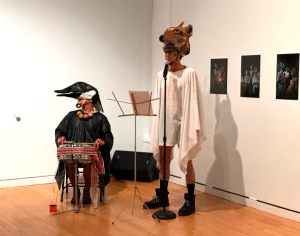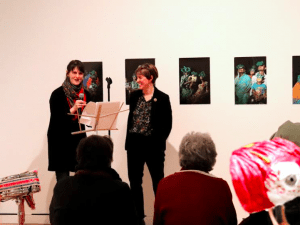
VOYAGER Exhibit Explores Migration at Emery Arts Center
Taylor Burke, Contributing Writer
The VOYAGER: Migrational Narratives exhibit introduces a conversation on migration to the UMF community through various mediums and perspectives. The exhibit, which is free to the public, opened from Jan. 30 to March 6.
Olivia Donaldson and Ann Bartges, curators of the exhibit, recently opened the gallery on a night that included live performances and virtual reality experiences. The exhibit features paintings, collages, photographs, textiles, sculptures, a poem and digital media pieces that viewers can watch and listen to. Each piece explores what it means to migrate and highlights experiences and perspectives on migration.
Donaldson, a French professor, has been researching migration and teaches global studies. She is passionate about migration and interested in the arts. Bartges is the director of the Emery Community Arts Center and a professor of visual arts.
Donaldson and Bartges were friends prior to the project which aided their collaboration. They began conversing about migration over a poem that became part of the exhibit. “In some ways, the poet launched the conversation between Olivia and I a long time ago,” Bartges said, “the poem kind of started the whole idea of the exhibition.” Bartges proposed the idea of the exhibit to Donaldson in her efforts to find ways that Emery could serve the rest of the campus, not just the art department.
The whole project took about a year to complete. “I don’t know if either of us really mapped that out when we started this,” Bartges said laughing with Donaldson. With Bartges’ background in art and Donaldson’s vision for interdisciplinary work, the two complemented each other in the curation process.

Arturo Herrera (left) and David Sanders (right) perform at the opening night for the VOYAGER exhibit. Photo Courtesy of Ann Bartges.
Donaldson and Bartges put out a call for submissions and were presented with a strong pool of pieces. “The works by artists who had experienced migration first hand had so much more depth,” said Bartges. “Those works just tended to have more layers,” she said.
Bartges and Donaldson’s decisions were influenced by their vision for the exhibit and tone they wanted to set. “We really didn’t want the show to become a binary conversation about whether migration is good or bad,” Donaldson said. “We wanted the show to be about connections.”
Bartges found Nayda Cuevas’ piece, “Adios: Puerto Ricans Always in Migration” to capture the tone they wanted for the exhibit. “We wanted to show this really human part of the migration experience,” she said.
This exhibit provides another perspective to understanding migration and its many facets. “We all engage with [migration] in newspaper headlines and in political language,” Bartges said. “But then there’s this other opportunity to engage in these issues through stories and narratives and experiences.”
One of the mediums, included only on opening night, was a virtual reality film called “A Shared Space: Lewiston,” created by documentary filmmaker Daniel Quintanilla and collaborators Shuab Mahat and Hilowle Aden. The film chronicles Mahat and Aden, two friends, who grew up in the Dadaab Refugee Camp in Eastern Kenya and currently live in Lewiston. “It looks at the challenges they each face in raising families in Maine during a time of rising nationalism, closed borders and travel bans,” Quintanilla said in an email.
The virtual reality experience allows viewers to immerse themselves in the content in ways other forms don’t allow for. “[A Shared Space: Lewiston] came out of a need to create content that could help others see and imagine the lives of others,” Quintanilla said.“We saw 360-degree cameras and headsets as a way to create virtual experiences in which we could invite viewers to enter spaces they might not be able to enter on their own.”
The creators of the film wanted to call attention to Maine’s connection with migration and the issues that surround it.“It’s too easy to be passive and think that families separated by ICE, borders, or policies is happening elsewhere,” Quintanilla said. “One of our goals is to highlight Maine’s relationship to global migration.”
This piece, like all of the others in the exhibit, is a way of storytelling and communicating human experiences. “I hope viewers are not only moved by the stories presented,” Quintanilla said in an email. “But can translate that empathy into action of some kind.”
Two of the pieces in the exhibit were created by creative writing professor, Éireann Lorsung. Her first work, “Completely out of Water,” is a collage piece from a series of 15 that she made during her time in Belgium.
Lorsung used this piece to play with English idioms while also channeling her own experience of being foreign. “What happens when you make an idiom literal?” she said. “What’s literally happening is very uncomfortable.” Although the literal meanings of idioms can cause discomfort, the piece was also supposed to evoke some humor due to the differences between the literal and metaphorical meanings of idioms.

Curators Ann Bartges and Olivia Donaldson speak at the opening night of the VOYAGER exhibit. Photo Courtesy of Ann Bartges.
Lorsung’s second piece, “Royaume de lumière x 144,” is part of a series of 144 small paintings that document the land that she lived on and had to leave. There is also a sound bit that goes along with the piece and plays a recording of the sounds from her garden.
When Lorsung left Belgium she lost her sheep and garden, among other things. “There’s no clear way to live through that,” Lorgsung said. “Art is a way that I’m trying to understand all that stuff.”
All the objects in the paintings are drawn from memory in an effort to reclaim what can’t be reclaimed. “Basically all the work I do is really thinking about having been an immigrant and what it meant to leave,” she said.
As an immigrant herself, Lorsung has noticed that migration is generally demeaning despite it being a natural and historical occurrence. “It’s borders and boundaries that are the new thing,” she said. “Human migration is not a new thing.”
Arturo Herrera, who is based in the Detroit area, was the creator of “The National Bird” piece displayed at the exhibit. “The National Bird is an experimental performance series highlighting several migratory animal disguises,” Herrera said in an email. “It builds on the premise that wild creatures can legally cross territorial boundaries anytime and anywhere without checkpoints.”
“The National Bird” gave and still gives Herrera the opportunity to create work that tells his personal story while not being directly about him. The piece is not finished and continues to evolve and grow, much like the subject of migration. “The work provides a different perspective on issues of relevant concern like immigration,” he said.
Herrera attended the opening night of the show and performed using two characters from his series. “[M]y impression was great of the show, as well as how every work in the gallery was speaking with each other,” he said in an email.

